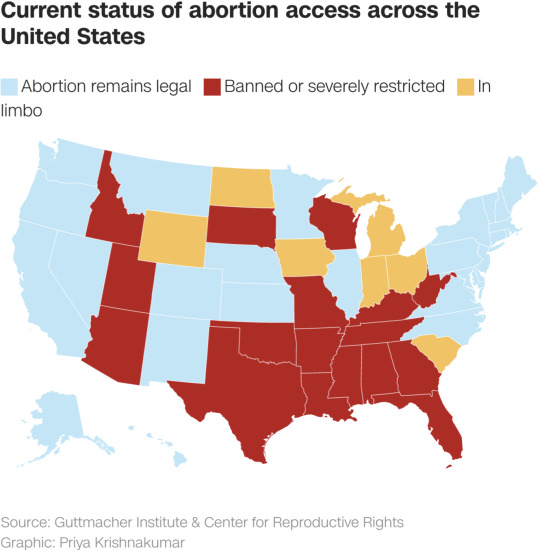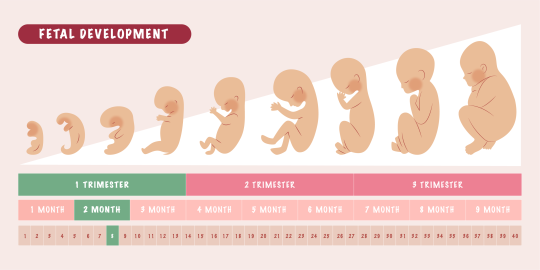#fetal healthcare
Text

#this is the type of care the unborn deserve#treatment#not death#pro-life#pro life#prolife#fetal care#fetal healthcare#twitter
3K notes
·
View notes
Text





This is what taking Alabama’s asinine ruling on embryos to its natural conclusion looks like
#politics#alabama#republicans#embryos#christian nationalism#abortion#reproductive rights#jay mitchell#religious reich#reproductive justice#healthcare#roe v wade#fetal personhood#justice jay mitchell#embrionics#ivf#criminalizing ivf#ivf treatment#christofascism#in vitro fertilization
273 notes
·
View notes
Text
Obviously, the Alabama Supreme Court actually putting fetal personhood into law is another victory for creeping Christian Authoritarianism and yet another attack on health care, womens' rights, and bodily autonomy....but watching the Republicans flip their shit now that IVF clinics are in danger of closing is hilarious in a "the clown car is on fire" kind of way.
Because of course this was going to happen. Fetal personhood and anti-surrogacy (especially in the context of same-sex parents) has been bouncing around in conservative religious and legal circles (but what's the difference?) for decades, with those pesky liberals warning about it for just as long. Anyone with an inkling of awareness of the issue could have seen it coming.
So the fact that they were caught so off guard is myopic enough. And they're panicking for a very good reason, because yanno who generally goes to IVF clinics?
The people who can afford it.
Certainly the abortion bans in various states were bad, but if you had a lot of disposable income you could just...go to another state. Extremely inconvenient, yes, but not insurmountable. But this?


Oh my god, now the far-right pro-life politics that you've been cultivating for going on fifty years is now in a position to affect people with money? People that matter? Now you have to try and contend with the very extremist judges you installed that don't have to worry about getting elected and whose decisions are now putting you on the political chopping block?
Join us the in misery you're created for everyone else, assholes.
#Oh no my own petard!#IVF#Fetal Personhood#Alabama Supreme Court#Politics#Republics#in vitro fertilization#Women's healthcare#Abortion#For real tho?#Watching Senator#Tommy Tuberville#stammer between the pro-life buzzwords and saying ''we believe people have to have more children''#(which...interesting. Which people do you think should have more children and why?)#and the inherent contradiction of pro-life politics outlawing fertility clinics - places that HELP PEOPLE HAVE CHILDREN#because guess what assholes? Pro-Choice goes BOTH WAYS#helping with things like FAMILY PLANNING to people who want and are prepared for children#why...it's almost like dismantling healthcare and taking away people's ability to make decisions about their lives and bodies and families#is...bad?
75 notes
·
View notes
Text
Pro lifers ain't saying nothing about the terrible conditions pregnant Gazan women are going through rn. Not that I'm shocked.
#angel posts#they're so goddamn loud where theyre not needed and then quiet when people actually want them to Mobilize#im not PL or anything it just reminds me how#pro lifism (?) only exists wrt to abortion#things kike healthcare maternal mortality and environmental issues#that lead to fetal demise or anything#get not a peep from them#women being killed while pregnant maternity wards destroyed and theyre quiet#again im not surprised#deeply annoyed tho
15 notes
·
View notes
Text
The rates of mothers and newborn babies dying during pregnancy, at birth or postpartum are much higher in states that currently ban or restrict abortions than in states preserving access, according to a new report.
The researchers analyzed data on deaths and other health outcomes using the most recent data available – from 2020 and earlier – and compared rates based on states’ current abortion access policies, as of November, after the Supreme Court decision this summer that overturned Roe v. Wade.
States that have restricted access to abortion services had maternal death rates in 2020 that were 62% higher than in states preserving access to abortion services. Between 2018 and 2020, the maternal death rate increased twice as fast in states that now have abortion restrictions, according to the report released Wednesday by the research foundation Commonwealth Fund.
Overall, death rates from any cause among women of reproductive age – 15 to 44 – were 34% higher in abortion-restriction states than in abortion-access states, according to the report.
The report also says that in 2019, fetal or infant death rates in the first week of life occurred at a 15% higher rate, on average, in states with abortion restrictions than in states with wider abortion access.
“Making reproductive services inaccessible to women and families can have dire consequences, and particularly, it varies by state,” said obstetrician/gynecologist Dr. Laurie Zephyrin, a co-author of the report and senior vice president for advancing health equity at the Commonwealth Fund.
In June the Supreme Court ruled on Dobbs v. Jackson Women’s Health Organization, which overturned Roe v. Wade, holding that there is no longer a federal constitutional right to an abortion and paving the way for states to ban abortions.

Based on the findings in the report, Zephyrin thinks maternal death rates in the US could worsen after the Dobbs decision.
“More people in the US die from complications of pregnancy and childbirth than any other developed nation, and most are preventable – and our rates are on the rise,” she said. “So I think that’s just very important as we think of this maternal health crisis and this collision of crises with this impact and this Dobbs decision.”
MATERNAL DEATH RATES 62% HIGHER IN ABORTION-RESTRICTION STATES
The new report – by researchers at Boston University and the Commonwealth Fund – includes data on state-by-state abortion policies and health outcomes among mothers and babies from sources including the US Centers for Disease Control and Prevention, the Health Resources and Services Administration and the nonprofit March of Dimes.
The researchers compared the health outcomes in 26 abortion-restricting states with those in the remaining 24 states and the District of Columbia, which appear to be unlikely to pass such restrictions.
The researchers found that slightly more than half – 55% – of US births in 2020 were in the 26 states currently with abortion bans or restrictions. In those states, births tended to be concentrated among women younger than 30, with 57% in women in that age group. In comparison, in abortion-access states, 45% of births were to women under 30.

The analysis also revealed that 39% of counties in states restricting abortion access fit the criteria to be considered “maternity care deserts,” meaning there is limited or no access to maternity health care services, such as an ob/gyn, hospital or birth center with obstetric care or certified midwives. In comparison, 25% of counties in abortion-access states can be considered maternity care deserts.
The researchers noted that a higher number of births in abortion-restriction states are in rural areas, where access to maternity care can be more limited and maternity care deserts more common. Rural areas had 17% of births in abortion-restriction states but 8% in abortion-access states.
The report also says that, between 2018 and 2020, the infant and perinatal mortality rates were 6.2 deaths per 1,000 births in abortion-restriction states, compared with 4.8 per 1,000 in abortion-access states. Across all racial and ethnic groups, infant mortality in the first year of life was higher in abortion-restriction states than in abortion-access states.
“What’s most surprising is, states have within their power to be able to avoid these outcomes,” Zephyrin said. “States really have it in their power to enhance maternal health capacity, really create the systems that are necessary to ensure that every person has an opportunity for a safe and healthy birth and life, whether we’re talking about recruiting maternity providers, providing more birthing centers, supporting the range of reproductive health services, expanding Medicaid, investing in postpartum Medicaid extension.”
Separate research published in 2020 in the journal Women’s Health Issues found that although maternal mortality overall continues to increase in the United States, the maternal death rate in states that have expanded Medicaid has had less of an increase than in non-expansion states.
“Compared with their counterparts in other states, women of reproductive age and birthing people in states with current or proposed abortion bans have more limited access to affordable health insurance coverage, worse health outcomes, and lower access to maternity care providers,” Zephyrin and her colleagues wrote in the new Commonwealth Fund report.
“Making abortion illegal risks widening these disparities, as states with already limited Medicaid maternity coverage and fewer maternity care resources lose providers who are reluctant to practice in states that they perceive as restricting their practice,” the researchers wrote. “The result is a deepening of fractures in the maternal health system and a compounding of inequities by race, ethnicity, and geography.”
‘THIS IS NOT HOW HEALTHCARE SHOULD BE’
Dr. Kristyn Brandi, the American College of Obstetricians and Gynecologists’ Darney-Landy Fellow, said she is not surprised by the findings in the new report because the “issues around reproductive health care are intricately linked.”
“My patients that seek abortion care are the same patients that need prenatal care in other pregnancies. Similarly, there is great data that suggests that the places that limit abortion also have higher maternal morbidity rates, less access to insurance, higher teen pregnancy rates, less access to sex education – the maps are overlapping,” Brandi, a practicing ob/gyn who was not involved in the research, wrote in an email to CNN.
She adds that restricting abortion care disproportionately affects marginalized communities, such as people with disabilities or travel limitations.
“It also means, similar to states that have only one abortion clinic, that the places where there are only one or a few labor and delivery units or prenatal care centers, those facilities will become overwhelmed with patients and that may create delays in care,” Brandi said. “This is not how healthcare should be. People should be able to access all reproductive health care services, regardless of their zip code.”
#us politics#news#cnn#abortions#abortion bans#reproductive health#reproductive rights#abortion is healthcare#2022#statistics#graphs#codify roe#roe v. wade#dobbs v. jackson women’s health organization#maternal death rate#Commonwealth Fund#infant death rates#fetal death rates#Dr. Laurie Zephyrin#Center for Disease Control and Prevention#Health Resources and Services Administration#March of Dimes#maternity care#perinatal mortality rates#infant mortality#expand Medicaid#expand medicare#Women’s Health Issues#Dr. Kristyn Brandi#American College of Obstetricians and Gynecologists
34 notes
·
View notes
Text
Ive come to the understanding that the times where im completely stuck on the floor feeling not so normal (really vague description of "i feel like im dying") i should really not ignore my body and go to the hospital but the hospital is expensive and ill live i just feel like im dying currently
#fuck the american healthcare system#ace of chaos in the now#ace be ranting#ace is stuck on the floor in the fetal position and feels like hes dying but meh his dad will be home with a chocolate bar eventually
5 notes
·
View notes
Text
Baby's First Beats: What to Expect at 8 Weeks Pregnant
Congratulations on making it to week eight of your pregnancy! This is an exciting milestone as your baby is growing rapidly and starting to develop recognizable features. By now, your baby is about the size of a raspberry and is beginning to resemble a tiny human being. While you may not be showing yet, you might be experiencing some early signs of pregnancy such as nausea, fatigue, and tender…

View On WordPress
#Baby&039;s first beats#Blood tests#Body changes#Breast tenderness#Due date#Eighth week#Emotional well-being#Exercise#fatigue#Fetal development#Food aversions#Food cravings#Healthcare provider#Healthy diet#Hydration#Medical history#Mood swings#Morning sickness#Pregnancy#Pregnancy Week by Week#Prenatal appointment#Prenatal care#Professional counseling#Rest#Self-care#Stress management#Support#Symptoms#Ultrasound#Unique pregnancy
2 notes
·
View notes
Text
it’s a travesty that my bath cannot get so close to boiling I finally feel clean of having to work retail
#rev speaks#texty#rev works retail#retail#it’s been over two years at this place#a whole fucking lot has happened#to the point where my father has said he’ll support me if I quit#until I can find something else#but he’s paying for my healthcare and this year that included two mris#BUT I HATE THIS JOB SO GOD DAMN MUCH#and I have had offers! but they’re not reasonable with a part time disabled body#and then today I get told they want me to up my hours????#I legitimately sat for two hours reading out loud important shit in fetal position because of pain#AHHH
2 notes
·
View notes
Text
Vitamin B12: What to Know
Vitamin B12: What to Know
Introduction:
Vitamin B12, also known as cobalamin, is a vital nutrient that plays a crucial role in maintaining overall health and well-being. Despite its importance, many individuals may not be aware of the signs of B12 deficiency or how it can impact their health. In this comprehensive guide, we’ll explore the significance of vitamin B12, common symptoms of deficiency, and strategies for…

View On WordPress
#anemia#animal products#B12 absorption#B12 deficiency#B12 deficiency treatment#B12 injections#B12 supplements#balanced diet#breastfeeding#cardiovascular issues#celiac disease#cobalamin#cognitive impairment#Crohn&039;s disease#dietary guidance#Dietary Guidelines#dietary intake#dietary recommendations#dietary sources#dietary supplements#DNA synthesis#fatigue#fetal development#gastric surgery#Gastrointestinal Disorders#Health and Wellness#Health Awareness#Health Education#health risks#Healthcare
0 notes
Text
Monitoring Tomorrow's Generations: Exploring the Fetal Monitoring Market
The global Fetal Monitoring market size is predicted an elevation up-to $ 5 Billion by 2030, witnessing a CAGR of 5.50% from 2024-2030.
The global fetal monitoring market observes is observing a substantial growth from past few years due to increasing government initiatives for welfare of mother and child, during the pre-partum, child-birth and post-partum period. Besides factors such as increasing awareness about maternal & fetal health, growing contributions by government & non-government organizations, and advancements in medical technologies, are expected to supplement the market growth in coming future.
#fetal monitoring market#life sciences and healthcare#medical devices#market research#market trends#business insights
0 notes
Text
What is Used to Monitor Fetal Heart Rate: A Comprehensive Overview
Monitoring fetal heart rate is a critical aspect of prenatal care, labor, and delivery. The technology and methods employed for this purpose have evolved over the years, providing healthcare professionals with accurate insights into the well-being of the baby. In this comprehensive overview, we will explore the tools and techniques used to monitor fetal heart rate.
1. Doppler Ultrasound:
Doppler ultrasound is a non-invasive method commonly used for monitoring fetal heart rate during prenatal check-ups and labor. It employs the Doppler effect, where sound waves bounce off moving objects, to detect and amplify the fetal heart sounds.
How it Works:
A handheld Doppler device, often equipped with a probe or transducer, is placed on the mother's abdomen.
The device emits ultrasound waves, which bounce off the moving blood cells in the fetal heart.
The returning sound waves create an audible representation of the fetal heart rate, allowing healthcare professionals to assess its rhythm and intensity.
Advantages:
Portable and easy to use.
Non-invasive and does not require extensive training.
Effective for intermittent monitoring during routine prenatal visits.
2. Electronic Fetal Monitoring (EFM):
Electronic Fetal Monitoring (EFM) is a more comprehensive and continuous method used during labor and delivery. It involves placing sensors on the mother's abdomen to monitor both the fetal heart rate and uterine contractions.
How it Works:
Two sensors are typically utilized—one to measure the fetal heart rate and another to monitor uterine contractions.
The fetal heart rate sensor detects the electrical signals generated by the baby's heart, while the contraction sensor measures the changes in the uterine muscle.
Advantages:
Provides continuous monitoring during labor, offering a detailed view of the baby's response to contractions.
Allows for simultaneous assessment of fetal heart rate and uterine activity.
Enables early detection of potential issues, prompting timely interventions.
3. Fetal Scalp Electrode:
A fetal scalp electrode is a specialized tool used for more direct and precise monitoring of the fetal heart rate during labor. It involves attaching an electrode to the baby's scalp.
How it Works:
During labor, the healthcare provider inserts a small electrode through the cervix and places it on the baby's scalp.
The electrode detects the electrical signals generated by the fetal heart, providing a highly accurate representation of the heart rate.
Advantages:
Direct and accurate measurement of fetal heart rate.
Continuous monitoring without the need for repositioning.
Effective in situations where external monitoring may be challenging.
4. Telemetry Monitoring:
Telemetry monitoring is a wireless method that allows mobility during labor while still providing continuous fetal heart rate monitoring.
How it Works:
Sensors are attached to the mother's abdomen, similar to traditional EFM.
However, instead of being connected to a bedside monitor, the data is transmitted wirelessly to a central monitoring system.
Advantages:
Allows freedom of movement for the mother during labor.
Continuous monitoring without being tethered to a stationary device.
5. Handheld Fetal Dopplers:
Handheld fetal Dopplers are simplified versions of Doppler ultrasound devices designed for home use. They are often used by expectant parents to listen to the baby's heartbeat between prenatal visits.
How it Works:
Similar to Doppler ultrasound, a handheld device is placed on the mother's abdomen.
The device emits ultrasound waves, and the returning sound waves create an audible heartbeat.
Advantages:
Provides reassurance for expectant parents between medical appointments.
Convenient for at-home use with proper guidance from healthcare professionals.
The tools used to monitor fetal heart rate cater to different stages of pregnancy and labor, each serving a specific purpose. From the simplicity of handheld Dopplers for occasional reassurance to the sophistication of electronic fetal monitoring for continuous assessment during labor, these tools collectively contribute to ensuring the safety and well-being of both the baby and the mother. As technology continues to advance, the field of fetal monitoring evolves, offering healthcare professionals an array of options to adapt their approach based on individual patient needs and clinical requirements.
0 notes
Text
#Artificial Womb Facility#Womb Technology#Market Research#Industry Advancements#Futuristic Healthcare#Reproductive Technology#Gestational Surrogacy#Pregnancy Alternatives#Fetal Development#Maternal Health#Neonatal Care
0 notes
Text

Just like wheat is not bread, embryos are not people
#politics#abortion#alabama#in vitro fertilization#reproductive rights#baby molly#embryos#healthcare#reproductive justice#roe v wade#religious reich#pro choice#ivf treatment#ivf#fetal personhood#criminalizing ivf#christofacism
197 notes
·
View notes
Text
Fetal Medicine Fellowship in Delhi to Advancing Expertise in Fetal Medicine with DMHCA

DMHCA offers a prestigious Fetal Medicine Fellowship in Delhi. Designed for medical professionals, this program provides comprehensive training, clinical exposure, and expert mentorship. With state-of-the-art facilities and experienced faculty, participants gain advanced knowledge in fetal diagnosis, management, and interventions. Join DMHCA's Fetal Medicine Fellowship in Delhi to enhance your expertise in this specialized field.
#fetal medicine fellowship#medicine fellowship#medical healthcare#medical courses#delhi medical#healthcare academy
0 notes
Text
AI-Enhanced Console Ultrasound Delivers Unprecedented Efficiency and Comprehensive Fetal Analysis
The field of ultrasound has seen a number of technological advances in recent years, but none have been as transformative as the introduction of artificial intelligence (AI). AI-enhanced ultrasound systems are now capable of automating many of the tasks that were once performed manually by radiologists, freeing them up to focus on more complex cases and providing patients with faster and more comprehensive care.
Read Full Blog Here: https://www.grgonline.com/post/ai-enhanced-console-ultrasound-delivers-unprecedented-efficiency-and-comprehensive-fetal-analysis
The Role of AI in Medical Imaging
Artificial intelligence has emerged as a game-changer in various industries, and healthcare is no exception. In medical imaging, AI algorithms are integrated into the console ultrasound system to augment the capabilities of healthcare professionals and enhance diagnostic accuracy. AI algorithms can analyze vast amounts of data in real-time, identifying subtle patterns and abnormalities that might be missed by the human eye alone. Moreover, AI systems can learn and improve from their experiences, making them increasingly adept at assisting healthcare providers in making accurate and timely diagnoses.
One of the most significant benefits of AI-enhanced ultrasound is its ability to improve efficiency. AI algorithms can automatically identify and track body structures, saving radiologists a significant amount of time. This is particularly beneficial in busy clinical settings, where radiologists often have to see a large number of patients in a short period of time.
In addition to improving efficiency, AI-enhanced ultrasound can also improve the accuracy of diagnoses. AI algorithms can be trained on large datasets of ultrasound images, which allows them to learn the subtle features that can be indicative of certain conditions. This can help radiologists to make more accurate diagnoses, which can lead to better patient outcomes.
One of the most promising applications of AI-enhanced ultrasound is in the area of fetal analysis. AI algorithms can be used to automatically identify and measure fetal structures, which can help to detect potential problems early on. This can be particularly beneficial for high-risk pregnancies, where early intervention can make a significant difference in the outcome of the pregnancy.
Here are some of the specific benefits of AI-enhanced console ultrasound:
Automated image analysis: AI algorithms can automatically identify and track structures in the body, which can save radiologists a significant amount of time.
Improved accuracy: AI algorithms can be trained on large datasets of ultrasound images, which allows them to learn the subtle features that can be indicative of certain conditions. This can help radiologists to make more accurate diagnoses.
Enhanced visualization: AI algorithms can be used to enhance the visualization of structures in the body, which can make it easier for radiologists to identify potential problems.
Personalized patient care: AI-enhanced ultrasound can be used to create personalized treatment plans for patients based on their individual needs.
Overall, AI-enhanced console ultrasound is a powerful new tool that has the potential to revolutionize the field of ultrasound. By improving efficiency, accuracy, and visualization, AI-enhanced ultrasound can help to provide patients with faster, more comprehensive, and personalized care.
Visit our website now: https://www.grgonline.com/

0 notes
Text
Fetal Monitoring Market is Segmented By Product (Ultrasound Devices, Electronic Maternal/Fetal Monitors, Uterine Contraction Monitor, 2D Ultrasound, 3D/4D Ultrasound, Doppler Imaging, Fetal Electrodes, Fetal Doppler Devices, Telemetry Devices, Accessories And Consumables, Other Products), By Portability (Portable Systems, Non-Portable Systems), By Method (Invasive, Non-Invasive), By Application (Antepartum, Intrapartum), By End User (Hospitals, Obstetrics And Gynecology Clinics, Home Care Settings), By Region (North America, Latin America, Europe, Asia Pacific, Middle East, And Africa) – Share, Size, Outlook, And Opportunity Analysis, 2023-2030
0 notes